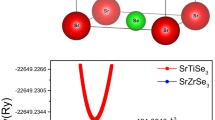Abstract
The electron structure of hydrogen in hcp Zr is calculated by using self-consistent nonlinear screening theory. The host-ion contribution is included through the spherical solid model potential (SSMP). The resulting charge density and scattering phase shifts are used to calculate the activation energy and residual resistivity of hydrogen in α-Zr matrix. The calculated activation energy 0·285 eV is found in reasonably good agreement with experimental value 0·3 eV. The estimated residual resistivity 0·53 μΩ cm/at% for Zr-H system using the scattering phase shifts agrees reasonably well with the observed value 0·27 μΩ cm/at%. The calculated configurational energy shows that hydrogen prefers tetrahedral(T)-sites over octahedral(O)-sites in α-Zr. The strong binding energy of electron-proton suggests that hydrogen forms zirconium hydride.
Similar content being viewed by others
References
Ashcroft N W 1966Phys. Lett. 23 48
Bickel P W and Berlincourt T G 1970Phys. Rev. B2 4807
Blatt F J 1957Phys. Rev. 108 285, 1204
Craig B I 1983Phys. Status Solidi(b) 115 53
Darby M I, Read M N and Taylor K N R 1978Phys. Status Solidi A50 203
Deutz J, Dedrichs P H and Zeller R 1981J. Phys. F11 1787
Friedel J 1952Philos. Mag. 43 153
Gunnarson O and Lundquist B I 1976Phys. Rev. B13 4274
Gupta M 1984The electronic structure of complex systems (eds) P Phariseau and W M Temmerman (New York: Plenum) NATO ASI Series Vol. 113 p 243
Gupta R P 1982J. Less-Common Met. 88 299
Harrison W A 1966Pseudopotentials in the theory of metals (New York: Benjamin)
Jena P and Singwi K S 1978Phys. Rev. B17 3518
Jena P, Fradin F Y and Ellis D E 1977Phys. Rev. B20 3543
Klein B M and Pickett W E 1982J. Less-Common Met. 88 231
Manninen M and Nieminen R 1979J. Phys. F9 1333
Manninen M, Nieminen R, Hautojärvi P and Arponen J 1975Phys. Rev. B12 4012
Manninen M, Hautojärvi P and Nieminen R 1977Solid State Commun. 23 795
Müller W M, Blackledge J P and Libowitz G G 1968Metal hydrides (New York: Academic Press)
Narang P P, Paul G L and Taylor K N R 1977J. Less-Common Metals 56 125
Perrot F and Rasolt M 1981Phys. Rev. B23 6534
Perrot F and Rasolt M 1982Phys. Rev. B25 7331
Popovic Z D, Stott M J, Carbotte J P and Piercy G R 1976Phys. Rev. B13 590
Sholl C A and Smith P V 1978J. Phys. F8 775
Singh N, Mahajan S and Prakash S 1981J. Less-Common Metals 77 265
Stritzker B and Meyer J D 1980Z. Phys. B38 77
Zaremba E, Sander L M, Shore H B and Rose J H 1977J. Phys. F7 1763
Author information
Authors and Affiliations
Rights and permissions
About this article
Cite this article
Singh, N., Avasthi, D. & Tripathi, A. Electron structure and activation energy of hydrogen in α-Zr using nonlinear response theory. Bull Mater Sci 20, 349–358 (1997). https://doi.org/10.1007/BF02745101
Received:
Issue Date:
DOI: https://doi.org/10.1007/BF02745101




